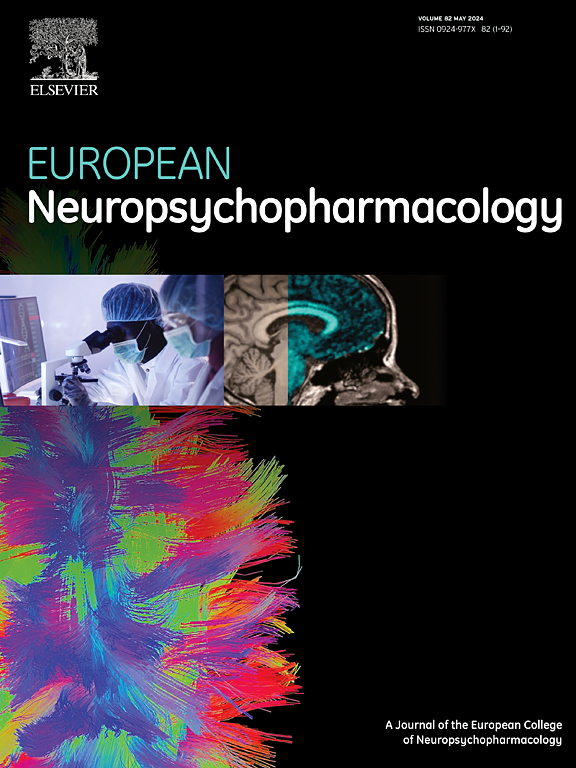THE IMPACT OF RARE GENETIC VARIANTS ON BRAIN STRUCTURE AND RISK FOR NEUROPSYCHIATRIC DISORDERS
IF 6.7
2区 医学
Q1 CLINICAL NEUROLOGY
引用次数: 0
Abstract
Background
Rare recurrent copy number variants (CNVs) have been implicated in atypical neurodevelopment and elevated risk for neuropsychiatric disorders. Among these, CNVs at the 22q11.2 locus (i.e., deletions or duplications on the long arm of chromosome 22) represent one of the most robust genetic risk factors for developmental neuropsychiatric conditions. The 22q11.2 deletion, occurring in ∼1 in 3,600 live births, is associated with markedly increased risk for autism spectrum disorder and schizophrenia. In contrast, the reciprocal 22q11.2 duplication, found in ∼1 in 1,200 live births, confers elevated risk for autism spectrum disorder but is associated with a reduced risk of schizophrenia relative to the general population. These reciprocal CNVs thus provide a unique model to investigate the neurobiological mechanisms underlying vulnerability and resilience to neuropsychiatric disorders. This presentation will highlight preliminary results showing that 22q11.2 CNVs are associated with substantial distribution shifts and regional brain structural variability beyond mean differences, as measured by magnetic resonance imaging, compared to controls. A novel neurodevelopmental model of the mechanisms underlying these alterations will also be discussed.
Methods
Magnetic resonance imaging data of 22q11.2 CNV carriers and unrelated, typically developing controls were derived from an ongoing longitudinal study (111 22q11.2 deletion carriers, 109 controls and 38 22q11.2 duplication carriers) and the world’s largest multi-site study on 22qDel (438 22q11.2 deletion carriers and 412 controls). Brain structural measures include cortical thickness, cortical surface area, cortical folding, intracranial volume, white matter volume and gray matter volume.
Results
22q11.2 deletion carriers show widespread increased cortical thickness and lower cortical surface area, characterized by a complete distribution shift in these measures compared to controls. The 22q11.2 deletion carriers also showed greater gray matter volume relative to white matter volume, which was related to individual differences in cortical surface area. In addition, there was a significant dosage effect (i.e., linear association between brain measures and copies of the 22q11.2 locus) on cortical folding (positive association) and cortical thickness (negative association).
Discussion and Conclusion
The 22q11.2 CNVs yield large effects on brain structure, resulting in a distribution shift in brain phenotypes among 22q11.2 deletion carriers. We posit that the consistently observed increased cortical thickness and lower cortical surface area in 22q11.2 deletion may represent increased neuronal density in deep cortical layers and reduced neuronal density in upper cortical layers. In contrast, 22q11.2 duplication may yield increased neuronal density in upper cortical layers, resulting in a thinner cortex and increased axonal tension. This may, in part, be driven by trans-effects of the 22q11.2 CNVs on genes implicated in thalamocortical axonal overgrowth (i.e., FOXP2 and ROBO2) and cortical expansion (i.e., PAX6). The relationship between lower and upper cortical layers may underlie vulnerability to schizophrenia and autism spectrum disorders.
罕见基因变异对大脑结构和神经精神疾病风险的影响
研究背景:复发性拷贝数变异(CNVs)与非典型神经发育和神经精神疾病风险升高有关。其中,22q11.2位点的CNVs(即22号染色体长臂上的缺失或重复)代表了发育性神经精神疾病最强大的遗传风险因素之一。22q11.2缺失与自闭症谱系障碍和精神分裂症的风险显著增加有关,发生在3600例活产婴儿中约1例。相比之下,每1200名活产婴儿中就有1人存在22q11.2重复,这增加了患自闭症谱系障碍的风险,但与一般人群相比,患精神分裂症的风险较低。因此,这些相互的CNVs提供了一个独特的模型来研究神经精神疾病脆弱性和恢复力的神经生物学机制。本报告将重点介绍初步结果,显示22q11.2 CNVs与大量分布变化和区域脑结构变异性相关,超出平均差异,通过磁共振成像测量,与对照组相比。一个新的神经发育模型的机制,这些变化也将讨论。方法22q11.2 CNV携带者和不相关的典型发育对照组的磁共振成像数据来自一项正在进行的纵向研究(111名22q11.2缺失携带者,109名对照和38名22q11.2重复携带者)和世界上最大的22qDel多位点研究(438名22q11.2缺失携带者和412名对照)。脑结构测量包括皮质厚度、皮质表面积、皮质折叠、颅内体积、白质体积和灰质体积。结果22q11.2缺失携带者表现出广泛的皮质厚度增加和皮质表面积降低,与对照组相比,这些测量指标的分布完全改变。22q11.2缺失携带者的灰质体积也比白质体积大,这与皮质表面积的个体差异有关。此外,在皮质折叠(正相关)和皮质厚度(负相关)上存在显著的剂量效应(即脑测量值与22q11.2位点拷贝数之间呈线性相关)。讨论与结论22q11.2 CNVs对大脑结构产生了很大的影响,导致22q11.2缺失携带者的大脑表型分布发生了变化。我们假设,在22q11.2缺失中一致观察到的皮质厚度增加和皮质表面积降低可能代表深部皮质层的神经元密度增加和上层皮质层的神经元密度降低。相反,22q11.2重复可能导致皮层上层神经元密度增加,导致皮层变薄和轴突张力增加。这在一定程度上可能是由22q11.2 CNVs对丘脑皮质轴突过度生长(即FOXP2和ROBO2)和皮质扩张(即PAX6)相关基因的反式效应驱动的。下皮层和上皮层之间的关系可能是精神分裂症和自闭症谱系障碍易感性的基础。
本文章由计算机程序翻译,如有差异,请以英文原文为准。
求助全文
约1分钟内获得全文
求助全文
来源期刊

European Neuropsychopharmacology
医学-精神病学
CiteScore
10.30
自引率
5.40%
发文量
730
审稿时长
41 days
期刊介绍:
European Neuropsychopharmacology is the official publication of the European College of Neuropsychopharmacology (ECNP). In accordance with the mission of the College, the journal focuses on clinical and basic science contributions that advance our understanding of brain function and human behaviour and enable translation into improved treatments and enhanced public health impact in psychiatry. Recent years have been characterized by exciting advances in basic knowledge and available experimental techniques in neuroscience and genomics. However, clinical translation of these findings has not been as rapid. The journal aims to narrow this gap by promoting findings that are expected to have a major impact on both our understanding of the biological bases of mental disorders and the development and improvement of treatments, ideally paving the way for prevention and recovery.
 求助内容:
求助内容: 应助结果提醒方式:
应助结果提醒方式:


